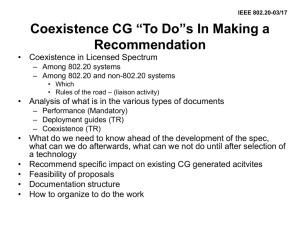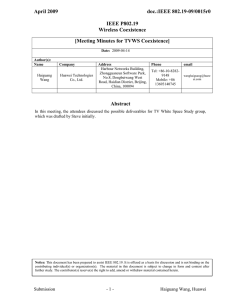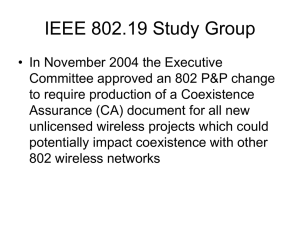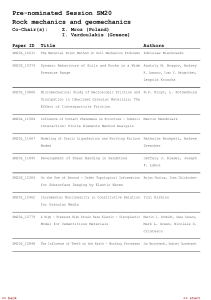July 2009 doc.:IEEE 802.19-09/0053r0 IEEE P802.19
advertisement
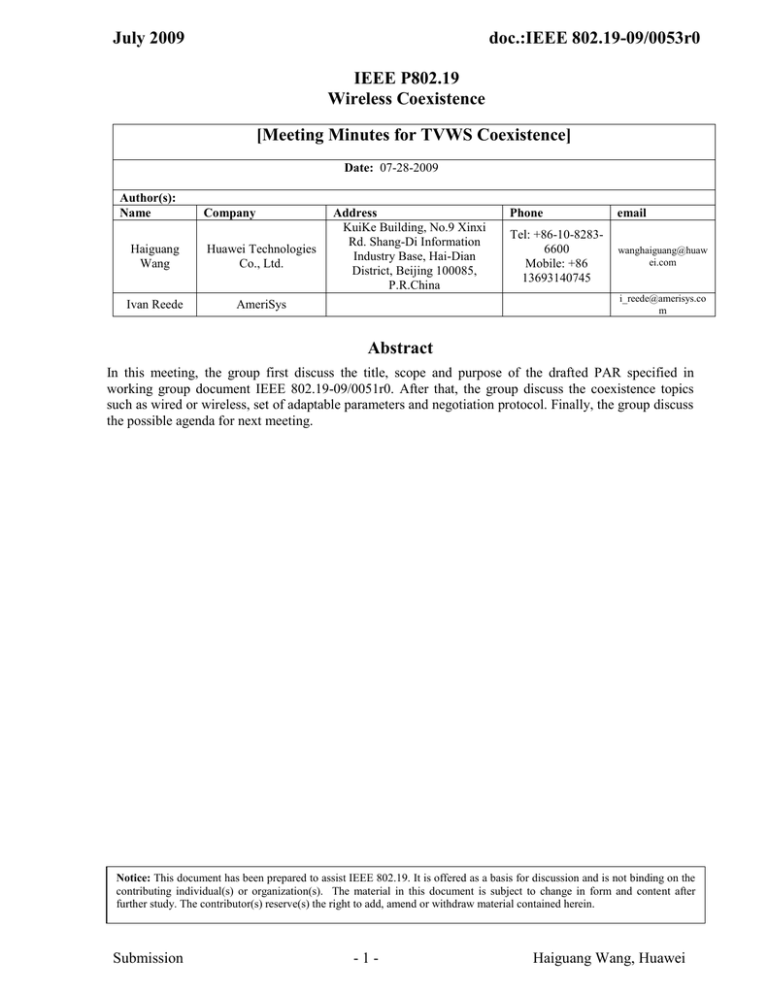
July 2009 doc.:IEEE 802.19-09/0053r0 IEEE P802.19 Wireless Coexistence [Meeting Minutes for TVWS Coexistence] Date: 07-28-2009 Author(s): Name Company Haiguang Wang Huawei Technologies Co., Ltd. Ivan Reede AmeriSys Address KuiKe Building, No.9 Xinxi Rd. Shang-Di Information Industry Base, Hai-Dian District, Beijing 100085, P.R.China Phone email Tel: +86-10-82836600 Mobile: +86 13693140745 wanghaiguang@huaw ei.com i_reede@amerisys.co m Abstract In this meeting, the group first discuss the title, scope and purpose of the drafted PAR specified in working group document IEEE 802.19-09/0051r0. After that, the group discuss the coexistence topics such as wired or wireless, set of adaptable parameters and negotiation protocol. Finally, the group discuss the possible agenda for next meeting. Notice: This document has been prepared to assist IEEE 802.19. It is offered as a basis for discussion and is not binding on the contributing individual(s) or organization(s). The material in this document is subject to change in form and content after further study. The contributor(s) reserve(s) the right to add, amend or withdraw material contained herein. Submission -1- Haiguang Wang, Huawei July 2009 doc.:IEEE 802.19-09/0053r0 ATTENDANCE Attendees Name Ivan Reede Haiguang Wang (Secretary) Alex Reznik Apurva Mody Ching-Tarng Hsieh Fanny Milinarsky Greg Phillips Hou-Shin Chen Joe Kwak Julan Hsu Kommate Jitvanichphaibool Mimi Tam Prabodh Varshney Victor Hou Wendong Hu 1.00 Affiliation AmeriSys Huawei Technologies Co., Ltd. InterDigital BAE ITRI octoScope AirTegrity Wireless, Inc Thomson InterDigital Samsung Institute for Infocomm Research octoScope Nokia Broadcom STMicroelectronics Meeting called to order Ivan 0 7:07 pm Ivan 0 7:07 pm The meeting is called to order by the vice chair, Ivan Reede. 2.00 Attendance Attendees are required to send their name and organization in through email to the Chair and Secretary. 3.00 Review IEEE Patent Policy Ivan 1 Ivan 47 7:08 pm The patent policy slides were brought up. 4.00 The group discuss the TVWS coexistence standardization issues 7:08 pm Agenda Attendance The IEEE patent policy is available at the following location o http://standards.ieee.org/board/pat/pat-slideset.pdf Discussion about what a PAR could look like (All) o Wired or Wireless communication link? o Set of adaptable parameter set? DFS, TPC, scheduling TX, channel splitting, etc. o Negotiation protocol? New Business The vice chair Ivan Reede suggests to discuss the title, scope and purpose of draft PAR in document in IEEE 802.19-09/0051r0. Submission -2- Haiguang Wang, Huawei July 2009 doc.:IEEE 802.19-09/0053r0 Ivan reads the title and scope of the draft PAR. Title: Standard for coexistence of IEEE 802-based devices operating in the white spaces of the TV bands. Scope: The standard provides a mechanism for IEEE 802-based heterogeneous networks to collaborate in order to coexist in the TV white space when there are a limited and dynamic number of channels. The mechanism will comply with regulatory requirements for the protection of licensed incumbent services Wendong Hu suggests add in the “interoperability” in the drafted scope. Joe Kwak requires Wendong to clarify what interoperability means. Does that mean the direct RF communication? Wendong says yes to question and further explain that the interoperability means that networks implement coexistence mechanisms A can coexist with networks implement coexistence mechanism B. Joe Kwak says that the work interoperability is misleading. He also suggests that we should not imply that we only support one coexistence mechanism in the draft PAR scope. Wendong emphasizes that we should ensure that network with different coexistence mechanisms can collaborate. Greg says that different coexistence mechanism should not have negative impact on each other. Joe Kwak states that the PAR scope is important to the standard and it should be precise and concise. He adds that Wendong’s question may not be proper for the scope. Ivan says that we can discuss but that does not mean we will put it in the PAR scope. Prabodh asks Wendong about the meaning of one network with coexistence mechanism A should be able to coexist with another network with coexistence mechanism B. Wendong gives an example that one network is with centralized coexistence mechanism and another network is with distributed coexistence mechanism. When networks with these two types of coexistence mechanisms co-located, they still can coexist. Prabodh says that if two networks coexist, they have to be collaborative. Ivan talks about the coexistence of devices with different transmission power level and suggests we address this issue somewhere. Prabodh supports Ivan’s suggestion and says that we should mention somewhere that different networks with different coexistence mechanisms. He asks whether different devices with different power levels can coexist, i.e. is this technically feasible? Although a distant 40 mW device can hear a 4W transmitter with 6dB SNR, it is highly improbable that the 4W device will be able to hear the distant 40mW device, there is an intrensic 20dB signal level problem, SNR will be -14 dB. Should we limit the scope or add a note somewhere to address this by stating that all cases cannot be covered or there is a limit to coexistence due to signal level disparity Ivan read the purpose of draft PAR and asks do we want to make any change. Joe Kwak states that we should allow multiple coexistence mechanisms. There is no other response to the change of the draft PAR purpose. Submission -3- Haiguang Wang, Huawei July 2009 doc.:IEEE 802.19-09/0053r0 Ivan goes back to the agenda prepared by the Steve. The first item is wired or wireless communication link. Someone asks why we should talk about this question. Why the “wired” is there? Ivan says that if devices want to access the database, they have to access it over the Internet. Someone responses that access of database cannot be over the TV White Space Spectrum. Ivan says that it is possible in some extreme cases. Someone adds that the AP or BS could “broadcast” channel availability. Stations/CPEs need not transmit to gain knowledge of channel availability. Joe Kwak suggests change the item to “communication over wireless with common physical layer or over backhaul Internet” Ivan says that the CSMA/CD protocol can address the coexistence amongst of heterogeneous protocol without needing these protocols understanding each other. Wendong says that it is a common protocol. Joe Kwak also mentions that CSMA/CD is not for heterogeneous. No furhter discussion on this topic is brought forward Ivan moves to the second item “Set of adaptable parameter set? DFS, TPC, scheduling TX, channel splitting, etc.” and asks for response. There is no response. Ivan moves to the third item “negotiation protocol.” and asks for response. Again there is no response. ” 5.00 New business Ivan 5 7:55 pm Ivan asks that whether we should fill in the 5 criteria. Somebody answers that we can go to the form and fill in the PAR form in this meeting. Ivan suggests we build agenda for meeting next week. He suggests we follow the suggestion and address the par form and start to fill in the items such as 5 criteria. He also encourages members of TVWS looking into the PAR and 5C and discussing it on the mailing list. 6.00 Submission Meeting closed Ivan -4- 0 8:00 pm Haiguang Wang, Huawei
